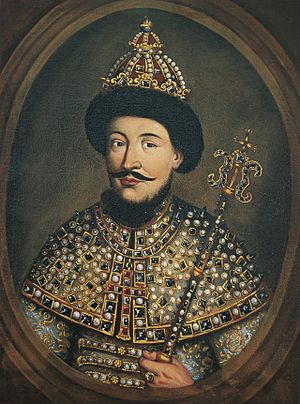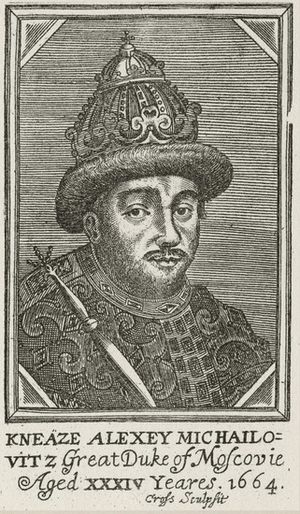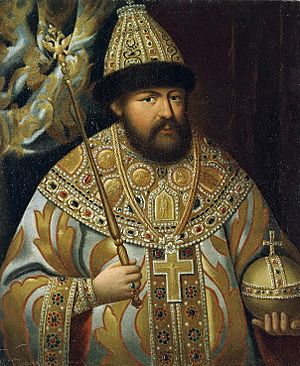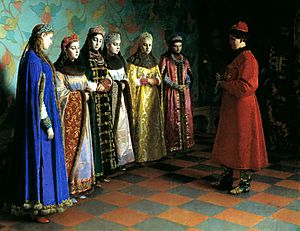Alexis of Russia facts for kids
Quick facts for kids Alexis I |
|||||
|---|---|---|---|---|---|
 |
|||||
| Tsar of Russia | |||||
| Reign | 12 July 1645 – 29 January 1676 | ||||
| Coronation | 28 September 1645 | ||||
| Predecessor | Michael | ||||
| Successor | Feodor III | ||||
| Born | 19 March 1629 Moscow, Russia |
||||
| Died | 29 January 1676 (aged 46) Moscow, Russia |
||||
| Burial | Archangel Cathedral | ||||
| Consort | Maria Ilyinichna Miloslavskaya Nataliya Kyrillovna Naryshkina |
||||
| Issue among others... |
Sofia Alexeevna Fyodor III Ivan V Peter I Natalya Alexeevna |
||||
|
|||||
| House | Romanov | ||||
| Father | Michael | ||||
| Mother | Eudoxia Streshneva | ||||
| Religion | Eastern Orthodox | ||||
Aleksey Mikhailovich; 19 March [O.S. 9 March] 1629 – 8 February [O.S. 29 January] 1676) was the tsar of Russia from 1645 until his death in 1676. His reign saw wars with Poland and Sweden, schism in the Russian Orthodox Church, and the major Cossack revolt of Stenka Razin. Nevertheless, at the time of his death Russia spanned almost 2,000,000,000 acres (8,100,000 km2).
Contents
Early life and reign

Born in Moscow on 19 March [O.S. 9 March] 1629, the son of Tsar Michael and Eudoxia Streshneva, the sixteen year old Alexei acceded to the throne after his father's death on 12 July 1645. In August, the Tsar's mother died, and following a pilgrimage to Sergiyev Posad he was crowned on 28 September in the Dormition Cathedral. He was committed to the care of his tutor Boris Morozov, a shrewd boyar open to Western ideas.
Morozov's pursued a peaceful foreign policy, securing a truce with the Polish-Lithuanian Commonwealth and carefully avoiding complications with the Ottoman Empire. His domestic policy aimed at limiting the privileges of foreign traders and abolishing a useless and expensive court offices. On 17 January 1648 Morozov procured the marriage of the tsar with Maria Miloslavskaya, himself marrying her sister, Anna, ten days later, both daughters of Ilya Danilovich Miloslavsky.
Morozov was regarded as a corrupt, self-seeking boyar and was accused of sorcery and witchcraft. In May 1648 Muscovites rose against his faction in the Salt Riot, and the young Tsar was compelled to dismiss them and exile Boris to the Kirillo-Belozersky Monastery. Four months later, Boris secretly returned to Moscow to regain some of his power.
The popular discontent demonstrated by the riot was partially responsible for Alexis' 1649 issuance of a new legal code, the Sobornoye Ulozhenie.
Later reign
Military reform
In 1648, using the experience of creating regiments of the foreign system during the reign of his father, Alexis began reforming the army.
The main direction of the reform was the mass creation of New Order Regiments: Reiters, Soldiers, Dragoons and Hussars. These regiments formed the backbone of the new army of Tsar Alexis. To fulfill the reform goals, a large number of European military specialists were hired for service. This became possible because of the end of the Thirty Years' War, which created a colossal market for military professionals in Europe.
Rebellions
Throughout his reign, Alexei faced rebellions across Russia. After resolving the 1648 Salt Riot Alexei faced rebellions in 1650 in the cities of Pskov and Great Novgorod. Alexei put down the Novgorod rebellion quickly, but was unable to subdue Pskov, and was forced to promise the city amnesty in return for surrender. The Metropolitan Nikon distinguished himself at Great Novgorod and in 1651 became the Tsar's chief minister.
By the 1660s, Alexei's wars with Poland and Sweden had put an increasing strain on the Russian economy and public finances. In response, Alexei's government had begun minting large numbers of copper coins in 1654 to increase government revenue but this led to a devaluation of the ruble and a severe financial crisis. As a result, angry Moscow residents revolted in the 1662 Copper Riot, which was put down violently.
In 1669, the Cossacks along the Don in southern Russia erupted in rebellion. The rebellion was led by Stenka Razin, a disaffected Don Cossack who had captured the Russian terminus of Astrakhan. From 1670 to 1671, Razin seized multiple towns along the Volga River. The turning point in his campaign was his failed siege of Simbirsk in October 1670. Razin was finally captured on the Don in April 1671, and was drawn and quartered in Moscow.
War against Safavid Iran
In 1651 Safavid troops attacked Russian fortifications in the North Caucasus. The main issue involved the expansion of a Russian garrison on the Koy Su River, as well as the construction of several new fortresses, in particular the one built on the Iranian side of the Terek River. The successful Safavid offensive resulted in the destruction of the Russian fortress and its garrison being expelled. In 1653 Alexis, initially thinking about sending the Zaporozhian Cossacks, eventually decided to send an embassy to Persia for a peaceful settlement of the conflict. In August 1653 courtier Prince Ivan Lobanov-Rostov and steward Ivan Komynin traveled from Astrakhan to Isfahan. Shah Abbas II agreed to settle the conflict, stating that the conflict was initiated without his consent.
Wars against Poland and Sweden
In 1653 the weakness and disorder of Poland, which had just emerged from the Khmelnytsky Uprising, encouraged Alexei to attempt to annex the old Rus’ lands. On 1 October 1653 a national assembly met at Moscow to sanction the war and find the means of carrying it out, and in April 1654 the army was blessed by Nikon, who had been elected patriarch in 1652.
The campaign of 1654 was an uninterrupted triumph, and scores of towns, including the important fortress of Smolensk, fell into the hands of the Russians. Ukrainian Hetman Bogdan Khmelnitsky appealed to Tsar Alexei for protection from the Poles, and the Treaty of Pereyaslav brought about Russian dominance of the Cossack Hetmanate in Left-Bank Ukraine.
In the summer of 1655, a sudden invasion by Charles X of Sweden briefly swept the Polish state out of existence, in what became known as the Deluge. The Russians, unopposed, quickly appropriated nearly everything that was not already occupied by the Swedes. When the Poles offered to negotiate, the whole grand-duchy of Lithuania was the least of the demands made by Alexei. However Alexei and the king of Sweden quarrelled over the apportionment of the spoils, and at the end of May 1656, with encouragement by the Habsburg emperor and the other enemies of Sweden, Alexei declared war on Sweden.
Great things were expected by Russia of the Swedish war, but nothing came of it. Dorpat was taken, but countless multitudes of men were lost in vain before Riga. In the meantime Poland had so far recovered herself as to become a much more dangerous foe than Sweden, and, as it was impossible to wage war with both simultaneously, the tsar resolved to rid himself of the Swedes first. In the Peace of Kardis (2 July 1661), Russia retroceded all her conquests.
The Polish war dragged on for six years longer and was then concluded by the Truce of Andrusovo (11 February 1667), nominally for thirteen years, which proved the most durable of treaties. According to the truce, Polotsk and Polish Livonia were restored to Poland, but the more important cities of Smolensk and Kiev remained in the hands of Russia together with the whole eastern bank of the Dnieper River. This truce was the achievement of Afanasy Ordin-Nashchokin, the first Russian chancellor and diplomat in the modern sense, who after the disgrace of Nikon became the tsar's first minister until 1670, when he was superseded by the equally able Artamon Matveyev, whose beneficent influence prevailed to the end of Alexei's reign.
Schism with the Old Believers
In 1653, Patriarch Nikon established a series of reforms that aimed to bring the practices of the Russian Orthodox Church into line with its Greek counterpart. Most notably, the church began to mandate the use of three fingers instead of two in making the sign of the cross. This resulted in significant dissent among the church community. Nevertheless, Alexei continued to support Nikon until 1658, when Nikon abandoned his post due to a personal insult, leaving the seat of the patriarch vacant.
In 1666, the tsar convened the Great Moscow Synod, which was attended by Patriarch Macarios III of Antioch and Patriarch Paisius of Alexandria, in order to address the problems caused by Nikon. The synod agreed to formally depose Nikon, and also decided to excommunicate all who opposed the reforms of the church; those opponents broke away from the official Russian Orthodox Church to form the Old Believers movement.
Family and children
Alexei's first marriage to Miloslavskaya was harmonious and felicitous. She bore him thirteen children (five sons and eight daughters) in twenty-one years of marriage, and died only weeks after her thirteenth childbirth. Four sons survived her (Alexei, Fyodor, Semyon, and Ivan), but within six months of her death, two of these were dead, including Alexei, the 15-year-old heir to the throne. The couple's children were:
- Tsarevich Dmitri Alexeevich (1648–1649); crown prince; died in infancy
- Tsarevna Yevdokia Alekseevna (1650–1712)
- Tsarevna Marfa Alekseyevna (1652–1707)
- Tsarevich Alexei Alexeevich (1654–1670); crown prince; died unwed aged 15
- Tsarevna Anna Alexeevna (1655–1659); died in infancy
- Tsarevna Sofia Alexeevna (1657–1704), regent of Russia (1682–89) for her two younger brothers; never married
- Tsarevna Ekaterina Alexeevna (1658–1718)
- Tsarevna Maria Alexeevna (1660–1723)
- Fyodor III (1661–1682); succeeded his father as Tsar of Russia; died childless
- Tsarevna Feodosia Alexeyevna (1662–1713)
- Tsarevich Simeon Alexeyevich (1665–1669); died in infancy
- Ivan V (1666–1696); was co-ruler along with his younger half-brother Peter the Great; father of Empress Anna
- Tsarevna Yevdokia Alexeevna (1669–1669)
Alexei remarried on 1 February 1671, Nataliya Kyrillovna Naryshkina ( 1 September 1651 – 4 February 1694). She was brought up in the house of Artamon Matveyev, whose wife was the Scottish-descended Mary Hamilton. Their children were:
- Peter I (1672–1725), known to history as "Peter the Great," Tsar of Russia
- Tsarevna Natalya Alexeevna (1673–1716)
- Tsarevna Fyodora Alexeevna (1674–1677)
Images for kids
See also
 In Spanish: Alejo I de Rusia para niños
In Spanish: Alejo I de Rusia para niños




